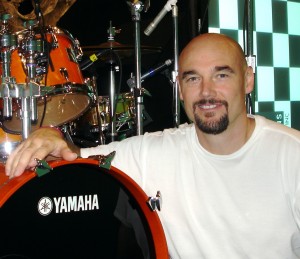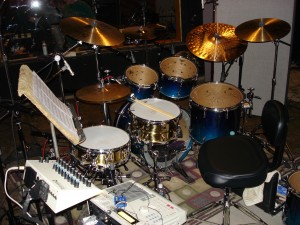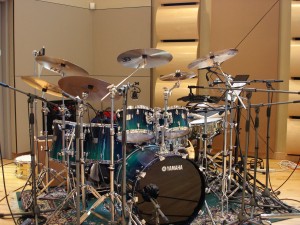I’ve always loved jazz. I was part of the founding jazz program at Webster University in St. Louis. It started the burn I have for that genre, and the fire never went out. You learn so much about pouring out of your heart & soul, and I believe this relates so much to what I feel in worship music. Even John Coltrane commented that his classic recording “A Love Supreme” was worship to God. Those early inspirations are firmly planted in me. The value of my Bachelors of Music degree is not in the plaque on my wall, but in the passion that it stirred in me as a young musician.
Here’s a clip recorded at Belmont University in Nashville with my friend, Professor David McKay, for his faculty recital. This is David’s tune “Colori.” Our band, Quad Venti, is the outlet for the love of this music. You can check out more QV songs at itunes. To book the group for your event contact my office. (615) 851-2850, or email LMAlbrecht@aol.com.
 Leann & I are enjoying working together in the studio. Contact me if you would like some “killer” vocals on your project or demo. This girl can sing!!! I can say that… can’t I. 🙂
Leann & I are enjoying working together in the studio. Contact me if you would like some “killer” vocals on your project or demo. This girl can sing!!! I can say that… can’t I. 🙂 Contact me for drum lessons via Skype or iChat; or at events when I travel; or here at my studio in Nashville. Please check my schedule for a city near you. You can reach me on Facebook, email (LMAlbrecht@aol.com),or my phone – 615-851-2850. I look forward to helping you on your drum journey.
Contact me for drum lessons via Skype or iChat; or at events when I travel; or here at my studio in Nashville. Please check my schedule for a city near you. You can reach me on Facebook, email (LMAlbrecht@aol.com),or my phone – 615-851-2850. I look forward to helping you on your drum journey.

 It’s amazing how often I hear from worship leaders, artists, and pastors that they are having trouble with a musician’s attitude. “They can play great, but they are just so hard to deal with!” Always complaining or arguing, and always “put out” by any request that might be made of them. A player like this is a “thorn in the side” of any music leader. This does not create a great working environment. And it probably works against any sense of unity and teamwork you are trying to build. In the secular world a player like this normally gets fired. “YO… YOU… YOU’RE OUTTA HERE!!” Problem solved!!! But we don’t do this in ministry situations. In the church we should be willing to ask someone to “sit out” for a while so they can work on some “personal issues”. That sounds so nice, doesn’t it? It could take weeks, maybe months. No matter how difficult this may be you must deal with it before it becomes a cancer in your team. Trust me, bad attitudes will infect or affect everyone. How do you deal with this if you are the one I’m talking about? What if you’ve become difficult to work with? Maybe you’ve found it difficult to serve others with your talents. Let me share some practical ideas as a drummer who has been asked to do many different and “stretching” things.
It’s amazing how often I hear from worship leaders, artists, and pastors that they are having trouble with a musician’s attitude. “They can play great, but they are just so hard to deal with!” Always complaining or arguing, and always “put out” by any request that might be made of them. A player like this is a “thorn in the side” of any music leader. This does not create a great working environment. And it probably works against any sense of unity and teamwork you are trying to build. In the secular world a player like this normally gets fired. “YO… YOU… YOU’RE OUTTA HERE!!” Problem solved!!! But we don’t do this in ministry situations. In the church we should be willing to ask someone to “sit out” for a while so they can work on some “personal issues”. That sounds so nice, doesn’t it? It could take weeks, maybe months. No matter how difficult this may be you must deal with it before it becomes a cancer in your team. Trust me, bad attitudes will infect or affect everyone. How do you deal with this if you are the one I’m talking about? What if you’ve become difficult to work with? Maybe you’ve found it difficult to serve others with your talents. Let me share some practical ideas as a drummer who has been asked to do many different and “stretching” things.






Recent Comments